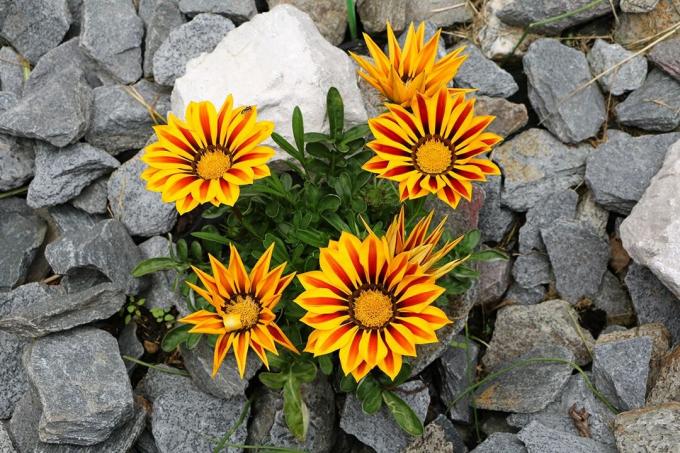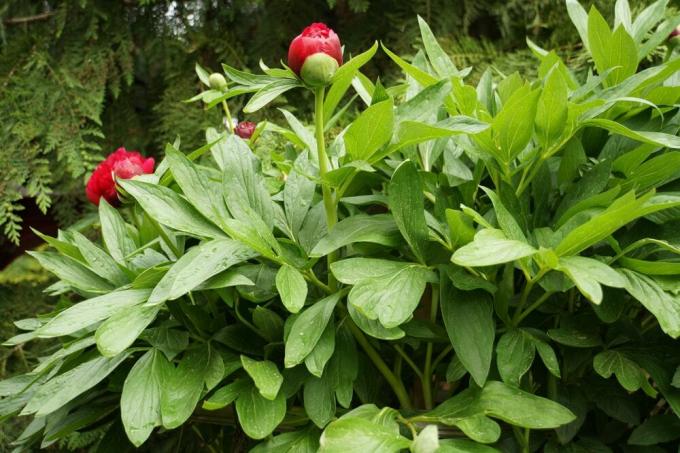

Table of contents
- Care
- wintering
- Plant
- head cuttings
- sowing
- division
- frequently asked Questions
- Worth knowing about gold spurge shortly
Gold spurge is characterized by its hemispherical growth and reaches a height of up to 50 cm. Thanks to the golden-yellow bracts and the copper-colored autumn color, this spurge plant is particularly attractive. The plant is hardy and also fits in a normal bed. Since the care is very easy and golden spurge is resistant to many pests, this garden plant causes little concern for a garden lover.
Gold spurge can be used in many garden areas such as wood edges or rock gardens. It is also ideal for green roofs and for near-natural hillside planting.
Care

Gold Spurge feels particularly comfortable in the sun, but also thrives in semi-shade. In small groups or tuffs of three to ten plants, this spurge plant comes into its own. Normally there is no need to water the plant as rain is perfectly adequate. Gold Spurge prefers well drained and dry soil. It thrives particularly well in alkaline soil conditions. If additional watering is required, only a small amount of water should be used. It is also important to ensure that there is no waterlogging. To stimulate the growth of the plant and provide it with additional nutrients, you can use cactus fertilizer. Gold Spurge is rarely attacked by pests and is also known as the “slug scare” as it is generally avoided by these voracious garden dwellers.
Tip:
A poisonous, milky substance can emanate from golden spurge. Therefore, you should always wear gloves when gardening.
In addition, it is important to ensure that small children and pets stay away from the plant.
wintering
Gold Spurge is conditionally hardy. To ensure that this plant survives the cold season well, it is covered with fir or deciduous branches before the first frost. If they are uncovered in good time in early spring, it is not possible for rot to develop. Additionally, care must be taken to protect golden spurge from the winter sun. When exposed to sunlight, it evaporates more moisture than it can extract from frozen ground. Therefore, this measure is necessary. In order to guarantee sufficient shade, a few fir fronds are sufficient. They are spread over the plant or stuck into the ground.
Plant
Most often, golden spurge reproduces by self-seeding. If you want to increase them in a targeted manner, there are various options. Particularly simple methods that hobby gardeners can carry out relatively quickly are division and top cuttings. If you decide to do a sowing, the preparation is a bit more complicated. One should not plant golden spurge in depressions. There is a risk that rot will develop in these places.
head cuttings
In spring or summer you can cut off the top cuttings with a sharp knife. Safety goggles and gloves should be worn during this process. Leave the cuttings for a few days to dry at the cutting point. They are then placed in the loosened potting soil at a selected location and lightly watered.
sowing
If you decide to propagate by seed, you should pay attention to controlled conditions. It is not recommended that sowing takes place directly in the bed. The reason is that the seeds dry up very quickly. In addition, they are often eaten by snails, birds or other animals. Since spurge plants are among the cold germs, they can be sown very early in the year. The seeds can be kept at a maximum temperature of 5 to 10 °C until they germinate. Experienced hobby gardeners put them in a plastic bag filled with a growing medium or moist sand. This sachet is kept in the fridge, but should never be placed in a freezer or freezer. During this time you have to make sure that the potting soil does not dry out and stays slightly moist at all times. If the substrate dries out completely, there is no possibility of germination. As soon as the first leaves appear, you can prick out the seedlings, place them in seed pots and take them outside. In the next few weeks they will develop continuously.
division
In addition to head cuttings and sowing, there is also the option of propagating gold spurge by division. For this purpose, carefully dig up the root ball of the milkweed. Afterwards it is divided with a knife or by hand. Care should be taken not to injure the roots unnecessarily. It is important to select rooted cuts. This allows them to grow faster in a new location.
frequently asked Questions
In principle, gold spurge does not make high demands on the soil quality and can therefore be used in a wide variety of ways. Nevertheless, you should make sure that the soil is permeable and dry. The plant thrives particularly well in calcareous soil.
Most of the time it is not necessary to water this plant. Rain is perfectly adequate. Otherwise you should water very sparingly and avoid waterlogging in any case.
Yes. Gold Spurge can survive the cold season in the garden unscathed. However, some precautions must be taken for overwintering so that the plant shines in full splendor again in spring.
A white, toxic liquid resembling milk in appearance can ooze from the plant. Therefore, you should always wear gloves when caring for and cutting. It is recommended to keep small children and pets away from the plant.
Gold spurge can be used in a variety of ways in the garden and is ideal for beds, rock gardens and also for creative green roofs.
Most often, gold spurge propagates by self-seeding. A hobby gardener has various planting methods available. The division is relatively simple. Planting top cuttings is also uncomplicated. Garden owners who have more experience can also opt for sowing. The preferred planting season is from spring to summer.
Worth knowing about gold spurge shortly
Characteristics
- Flowering period: May to June with green-yellow, small, inconspicuous flowers in bright yellow bracts in umbrella-shaped inflorescences
- Note: Bracts are more often mistakenly referred to as flowers and remain colorful with tremendous luminosity throughout the summer
- Foliage: Ovate, dark green, softly hairy leaves with striking red autumn colors and mostly reddish shoots
- Growth: clump-like, strongly branched growth with cushion-like spread over the branched rootstock
- Height: Gold Spurge reaches 30 to 50 cm
- Location: sunny and warm, also in front of south faces; also tolerates partial shade, although full sun is preferred; well drained, nutrient-rich, calcareous, moderately dry soil
plant and care
- Planting time: can be sown in spring or autumn
- Neighborhood: fits well on gravel areas and as planting along the edges of paths
- Pruning: Cut back in late autumn or early spring before new growth
- Propagation: Division in spring after flowering (see below for propagation), can also be sown in spring
- Care: Watering is not necessary, rain is usually sufficient.
- Fertilization: Leave fallen leaves, they are processed into humus by soil organisms, then no fertilization is necessary
- Hibernation: hardy
- Special features: even the smallest injury to the plant releases a toxic, skin-irritating milky sap that can be dangerous for children and pets
Known variety
- 'Purpurea': interesting contrast between yellow bracts and reddish leaves
propagation
- Cut off leaves and keep fresh cut and lukewarm water to stop milk flow.
- Then let them dry for at least a few hours or days so that they don't rot later in the ground.
- Then they are put into potting soil with the shortened stalk.
 garden editorial
garden editorial I write about everything that interests me in my garden.
Learn more about flowers

Midday gold, Gazania: proper care and wintering
The midday gold, which impresses with its colorful and sun-loving flowers, is one of the most popular perennials for local gardeners. The right tips for caring for and overwintering the Gazania have been put together for you here.

Caring for, overwintering and cutting asters | Instructions
The radiant flowers of the asters enchant every garden as well as in pots, terraces and balconies, depending on the variety, from May until well into autumn. Caring for the perennials is not that difficult if everything is known about wintering and cutting.

Magnificent pier, Astilbe: care instructions from A - Z
Astilbe is very popular in the garden. Still, gardeners need to consider a few things if they want the plants to thrive. In our A-Z care instructions, you will learn everything you need to know about the splendor, from flowering to winter protection.

California Poppy, Eschscholzia californica: Care Instructions
Hardly any garden plant is as easy to care for as Californian poppy (Eschscholzia californica), which, with its golden yellow flowers, is a feast for the eyes in the home garden. In order to ensure the bright sea of flowers, a few points should be considered with regard to care.

17 hardy bee-friendly flowers
There has been talk of bee deaths for years. You absolutely need help to survive. Bees are an important part of our ecosystem. Garden owners can also help the small insects with the design of their green oasis.

When do peonies bloom? | Beginning and duration of the flowering period
Peonies are garden perennials that, after a few years, form a veritable sea of flowers in early summer. The individual flowers are long-lasting and are also suitable for cutting. Depending on the variety, they bloom in different colors. But when exactly is the heyday?
